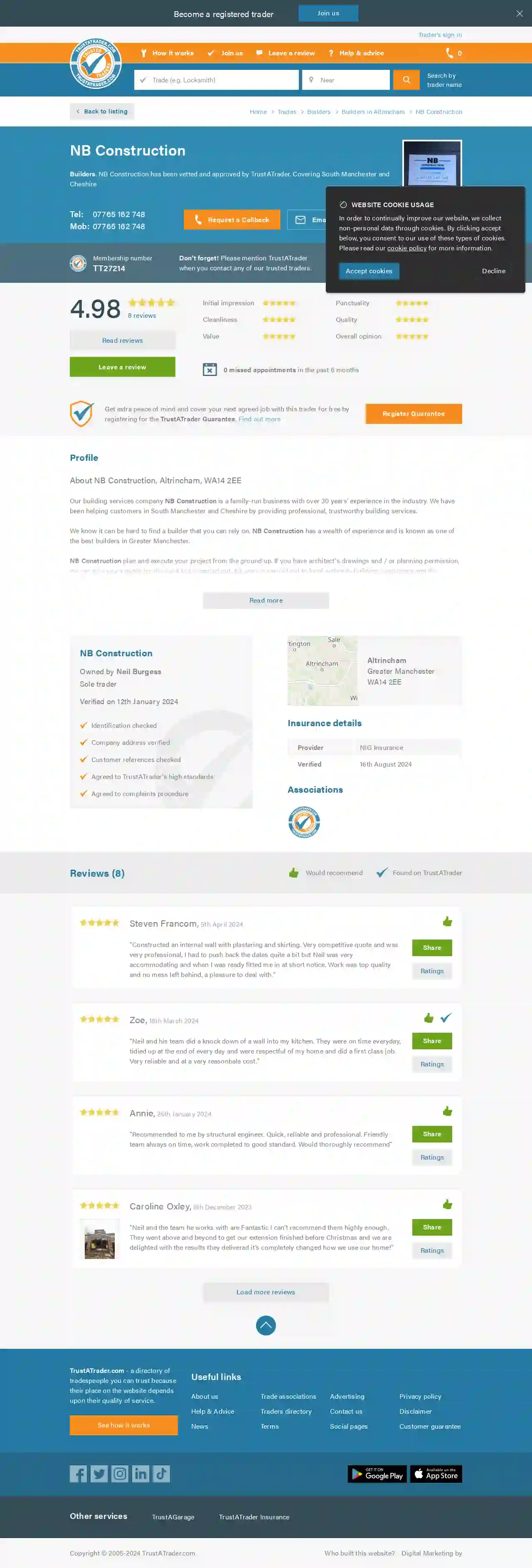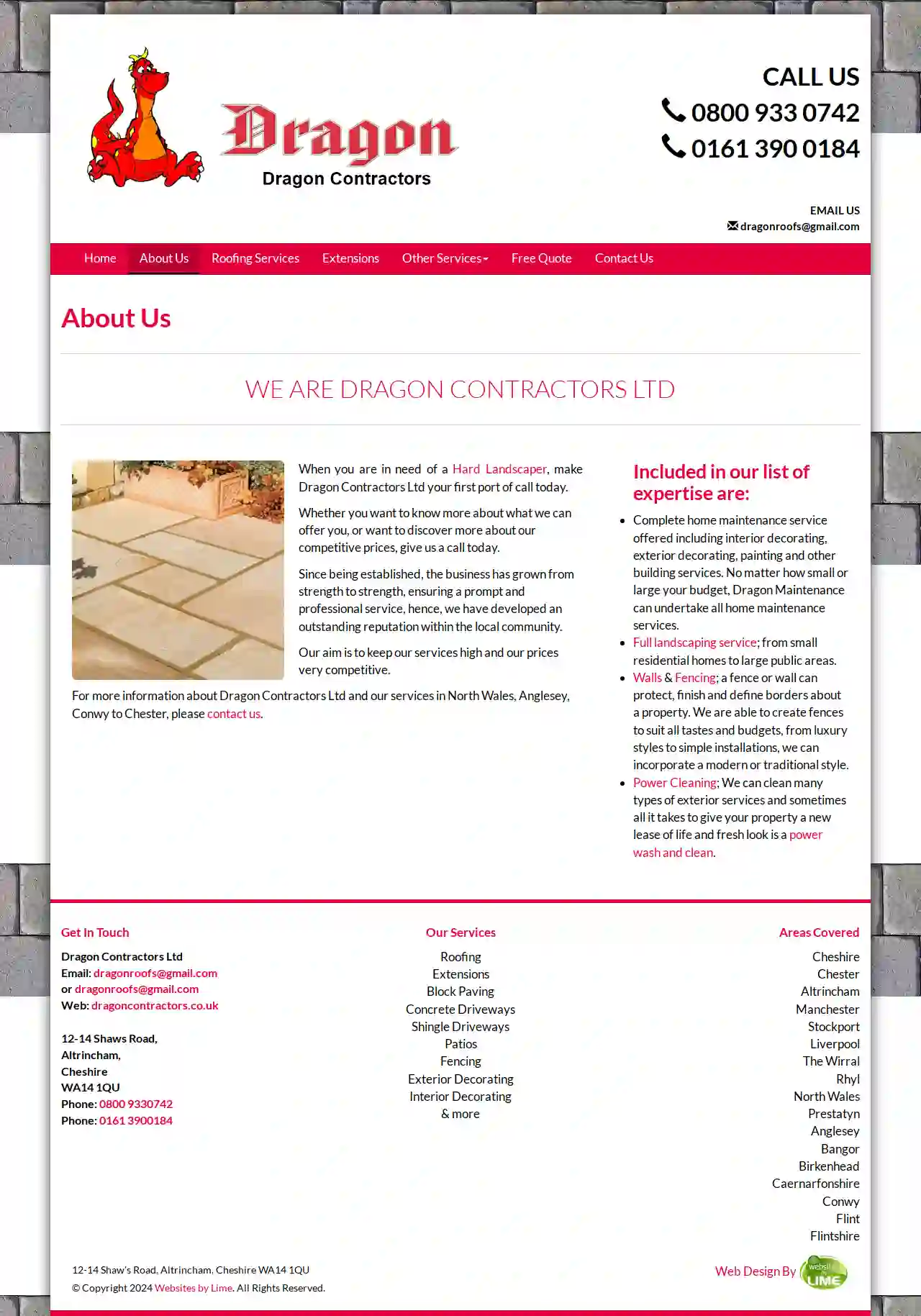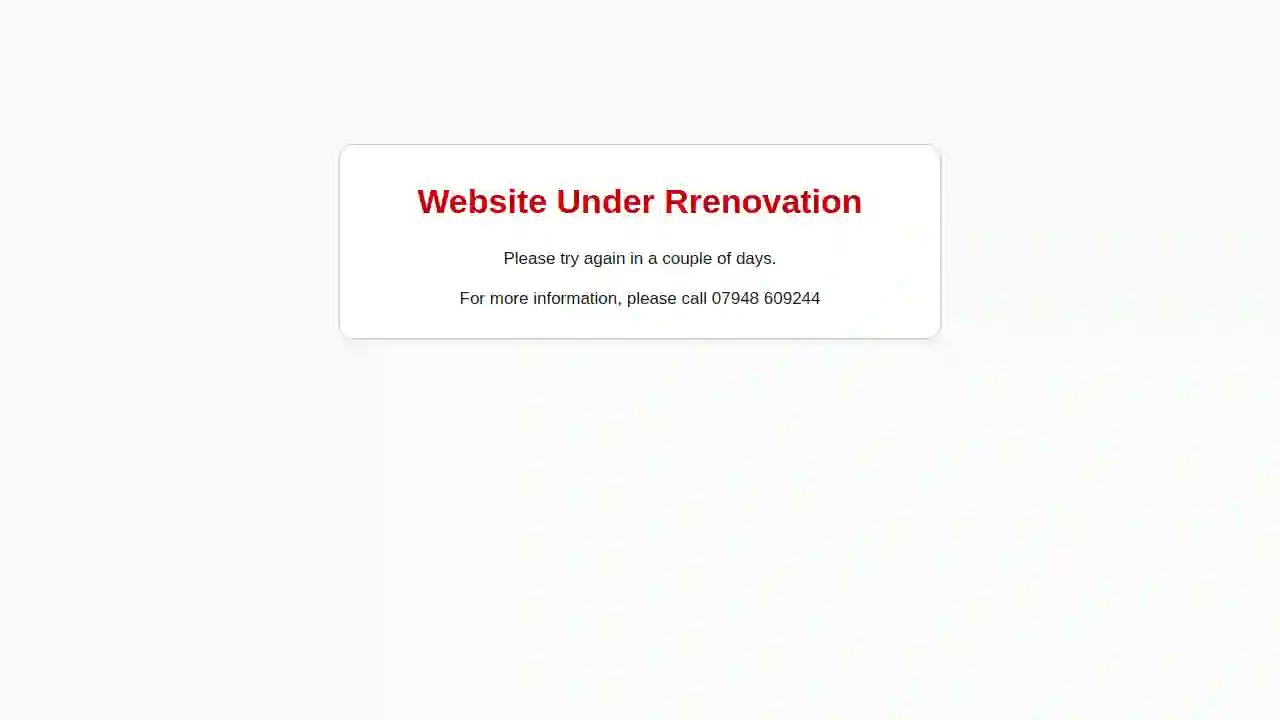Excavation Contractors Davyhulme
Top 10 Excavation Contractor in Davyhulme
Receive 3 FREE Excavation Companies quotes for your project today! Compare profiles, reviews, accreditations, portfolio, etc... and choose the best deal.

NB Construction
510 reviewsAltrincham, WA14 2EE, GBAbout NB Construction, Altrincham, WA14 2EE Our building services company NB Construction is a family-run business with over 30 years’ experience in the industry. We have been helping customers in South Manchester and Cheshire by providing professional, trustworthy building services. We know it can be hard to find a builder that you can rely on. NB Construction has a wealth of experience and is known as one of the best builders in Greater Manchester. NB Construction plan and execute your project from the ground up. If you have architect's drawings and / or planning permission, we can give you a quote for the work to be carried out. All work is carried out to local authority building regulations and the required gas / electrical certificates supplied when appropriate. We pride ourselves on providing a professional, caring and high-quality service and always meet our customers’ needs. Each contractor that works for NB Construction is fully qualified and insured and delivers on timekeeping, quality of work and value. We offer a full range of building services, from major rebuilds to smaller jobs such as masonry repairs, including: New Builds Alterations, Extensions & Conversions Restoration Work Renovation Projects Internal/External Wall Removal Structural Works Brickwork Concrete Plastering & Screeding Tiling Painting & Decorating Kitchens & Bathrooms Roofing Services Re-pointing Septic Tanks Excavation Services Soakaways Foundations External Works Drainage
- Services
- Why Us?
- Testimonials
- Gallery
Get Quote
M.MILLS Building Contractors Ltd
34 reviewsAltrincham, GBBUILDERS IN ALTRINCHAM, CHESHIRE Expert builders in Altrincham, Cheshire and South Manchester with over 30 years experience in helping you turn your vision into a reality. 6 YEAR WARRANTY WITH ALL BUILDING WORKS We are committed to providing our clients with the highest quality workmanship and peace of mind. That's why we offer a 6-year warranty on all of our building works.
- Services
- Why Us?
- Accreditations
- Gallery
Get Quote
Select Driveways & Patios Ltd
551 reviewsBizspace Atlantic Business CentreAtlantic StAltrincham, Altrincham, WA14 5NQ, GBAbout Select Driveways & Patios Ltd Select Driveways and Patios Ltd specialise in a wide variety of driveways and block paving work, with many years experience with in the trade. Our experienced and professional staff can offer you free impartial advice on all your block paving driveway requirements. With years of experience in the building field, you can be confident of our quality and reliability. All our work is fully guaranteed and carried out to your total satisfaction. Select Driveways & Patios offer a full range of traditional colours and designs along with a complete service, with site preparation if necessary. Our Services We can provide the following Driveways & Landscaping services: Decorative walling Tegula Paving Tarmac Driveways Concrete Driveways Imprinted Concrete Driveways Gravel Driveways Cobblestone Driveways Glass Driveways Resin Driveways Block Paving Indian Stone Slabbing Slabbing Fencing Landscaping If you have a particular style in mind that is not shown here, please discuss your ideas with us as your complete satisfaction is our sole aim.
- Services
- Why Us?
- Testimonials
- Gallery
Get Quote
ACAD design and surveys
51 reviews15 Attenburys Lane, Timperley Chesire, 15 Attenburys Lane Timperley Chesire, Timperley, WA14 5QE, GBAbout ACAD Paul and David formed ACAD design and surveys with a view to create a successful state of the art company. Leading the way for architectural design and building/land surveys, specializing in 3D scanning. Previously Paul and David both owned successful companies within the industry. The aim of ACAD is to become the UK’s leading survey and design company, offering a bespoke professional service covering the whole of the UK & Europe. Working alongside a tight knit team of experienced professionals, in all areas of the survey & design industry. Paul and David’s close friendship and understanding helps ACAD to run, with positive attitude and creates a happy relaxed working environment. We pride ourselves on perfection, precision and forming close ongoing client relationships. To discuss your project call us on: 0161 710 2861
- Services
- Why Us?
- Our Team
- Testimonials
- Gallery
Get Quote
Pownall Plant Ltd
3.76 reviewsAshley, Altrincham, Bollin View, Mill Lane, WA15 0RD, GBAbout Pownall Plant Pownall Plant is a trusted local firm specializing in excavation, groundworks, and a wide range of services. We've been in business since 1999, committed to delivering high-quality results using the best machinery and materials. Beyond our standard services like topsoil, groundworks, and plant hire, we offer specialized solutions including foundations, underground drainage, concreting, sewage treatment plants, and more. Explore our Special Projects page for detailed information on these services.
- Services
- Why Us?
- Gallery
Get Quote
GreenStruction
35 Stamford New Road, Altrincham, England, WA14 1EB, GBAbout GreenStruction GreenStruction is a family run business, well established and working both on a commercial and residential basis. We pride ourselves on attention to detail, customer relations and differentiate in what we can accomplish. We are committed in offering a bespoke and tailored service - to meet the current demand in Landscape and Gardening. Our Mission GreenStruction is a full-service landscape Gardening company with a straightforward and unique design/build philosophy. We believe in having one landscape designer handle the job from its conception on paper, to the realization on your property. The reason; by doing this you are able to communicate and work with a single individual, where you can share your thoughts and idea's with to bring them, in collaboration, to life. Our Team The Company is made up of a group of highly skilled landscaping professionals who pay a lot of attention to small details. In the 10+ years of experience, our staff keep your property looking and functioning beautifully. Our landscapers are fully insured & experienced in the field.
- Services
- Why Us?
- Gallery
Get Quote
Dragon Contractors Ltd
12-14 Shaws Road, Altrincham, WA14 1QU, GBAbout Dragon Contractors Ltd Dragon Contractors Ltd is a well-established and reputable company specializing in a wide range of services, including roofing, extensions, driveways, landscaping, and home decorating. We have a team of experienced professionals who are dedicated to providing high-quality workmanship and exceptional customer service. We understand that your home is your most valuable asset, and we take pride in delivering projects that meet your specific needs and exceed your expectations. Whether you're looking for a complete home maintenance service, a full landscaping makeover, or a new driveway, we have the expertise and resources to handle any project, big or small. Our commitment to quality and customer satisfaction has earned us a strong reputation within the local community. We offer free estimates, free advice, and free site surveys, ensuring that you have all the information you need to make informed decisions about your project. We are proud to serve the following areas: Cheshire, Chester, Altrincham, Manchester, Stockport, Liverpool, The Wirral, Rhyl, North Wales, Prestatyn, Anglesey, Bangor, Birkenhead, Caernarfonshire, Conwy, Flint, and Flintshire. Contact us today to discuss your project and get a free quote.
- Services
- Why Us?
- Testimonials
- Gallery
Get Quote
Somnium Commercial
59 reviewsBooth Road, Sale, M33 7JH, GBAbout Somnium Commercial Building Contractors At Somnium, when it comes to commercial construction, we commit to excellence. We specialize in providing comprehensive construction solutions tailored to meet the needs of our clients. From concept to completion, our team of professionals brings unparalleled expertise and dedication to every project we undertake.
- Services
- Why Us?
- Our Team
- Gallery
Get Quote
PD Drives & Patios LTD
32 reviews123 Main Street, [CITY], 12345, GBAbout PD Drives & Patios PD Drives & Patios is a family-owned and operated business serving the [CITY] area for over 20 years. We specialize in providing high-quality driveway and patio installations, using only the best materials and experienced craftsmanship. Our commitment to customer satisfaction is evident in our meticulous attention to detail and our dedication to exceeding expectations. We take pride in building lasting relationships with our clients, ensuring their complete satisfaction with every project. We understand that your driveway and patio are an extension of your home, and we treat every project with the care and respect it deserves. From initial consultation to final completion, we work closely with you to ensure your vision is brought to life. Our team of experts is dedicated to providing you with the best possible service, from design and planning to installation and maintenance. We offer a wide range of services to meet your specific needs, including: Driveway installation and repair Patio installation and design Concrete work Paver installation Landscaping Contact us today for a free consultation and let us help you create the outdoor space of your dreams.
- Services
- Why Us?
- Testimonials
Get Quote
ixsia Construction Ltd
Altrincham, GBIXSIA Construction is a construction company based in the UK. They are currently under renovation, but you can reach them by phone at 07948 609244 for more information.
- Services
- Why Us?
Get Quote
Over 13,059+ Excavation Pros registered
Our excavation experts operate in Davyhulme & surrounding areas!
ExcavationHQ has curated and vetted Top Excavation Companies arround Davyhulme. Find the most reliable pro today.
Frequently Asked Questions About Excavation Contractors
- Utility Locates: Contact your utility companies to mark the locations of underground lines before excavation begins. This is usually a free service.
- Hand Digging: Excavate carefully by hand near marked utility lines to avoid damage.
- Potholing: Digging small test holes to expose and verify utility depths and locations.
- Safe Distances: Maintaining a safe distance between excavation equipment and marked utility lines.
- Vacuum Excavation: Using vacuum excavation techniques to expose utilities without digging, reducing the risk of damage.
- Project Size and Scope: The larger and more complex the excavation, the higher the cost.
- Soil Type: Different soil types require different equipment and techniques, impacting costs. Rocky or clay-rich soil can be more expensive to excavate than loose soil.
- Accessibility: Difficult-to-access sites might require specialized equipment or additional labor, increasing expenses.
- Disposal Costs: Hauling away excavated material (soil, rocks, etc.) to disposal sites incurs additional fees.
- Permits and Inspections: Depending on local regulations, permits and inspections might be required, adding to the overall cost.
- Basement Size: The larger the basement, the more excavation is required, increasing the cost.
- Soil Type: Excavating rocky or dense clay soil is generally more expensive than loose soil.
- Accessibility: Difficult-to-access sites might require specialized equipment or more labor, driving up costs.
- Foundation Type: The chosen foundation type (full basement, crawl space, slab) affects excavation needs.
- Underpinning: If underpinning (strengthening existing foundations) is necessary, it significantly increases costs.
- Disposal Fees: Hauling excavated soil to disposal sites adds to the overall expense.
- Sloped Property: Your property has a significant slope, making it prone to soil erosion or landslides.
- Creating Usable Space: You want to level off a sloped area to create a flat surface for patios, gardens, or other outdoor spaces.
- Preventing Damage: Erosion is threatening existing structures, driveways, or walkways.
- Landscaping Features: You're incorporating tiered gardens, raised beds, or other landscaping elements requiring soil retention.
How do you protect utilities during excavation?
How much does excavation cost?
How much does it cost to excavate a basement?
How do I know if I need a retaining wall?
How do you protect utilities during excavation?
- Utility Locates: Contact your utility companies to mark the locations of underground lines before excavation begins. This is usually a free service.
- Hand Digging: Excavate carefully by hand near marked utility lines to avoid damage.
- Potholing: Digging small test holes to expose and verify utility depths and locations.
- Safe Distances: Maintaining a safe distance between excavation equipment and marked utility lines.
- Vacuum Excavation: Using vacuum excavation techniques to expose utilities without digging, reducing the risk of damage.
How much does excavation cost?
- Project Size and Scope: The larger and more complex the excavation, the higher the cost.
- Soil Type: Different soil types require different equipment and techniques, impacting costs. Rocky or clay-rich soil can be more expensive to excavate than loose soil.
- Accessibility: Difficult-to-access sites might require specialized equipment or additional labor, increasing expenses.
- Disposal Costs: Hauling away excavated material (soil, rocks, etc.) to disposal sites incurs additional fees.
- Permits and Inspections: Depending on local regulations, permits and inspections might be required, adding to the overall cost.
How much does it cost to excavate a basement?
- Basement Size: The larger the basement, the more excavation is required, increasing the cost.
- Soil Type: Excavating rocky or dense clay soil is generally more expensive than loose soil.
- Accessibility: Difficult-to-access sites might require specialized equipment or more labor, driving up costs.
- Foundation Type: The chosen foundation type (full basement, crawl space, slab) affects excavation needs.
- Underpinning: If underpinning (strengthening existing foundations) is necessary, it significantly increases costs.
- Disposal Fees: Hauling excavated soil to disposal sites adds to the overall expense.
How do I know if I need a retaining wall?
- Sloped Property: Your property has a significant slope, making it prone to soil erosion or landslides.
- Creating Usable Space: You want to level off a sloped area to create a flat surface for patios, gardens, or other outdoor spaces.
- Preventing Damage: Erosion is threatening existing structures, driveways, or walkways.
- Landscaping Features: You're incorporating tiered gardens, raised beds, or other landscaping elements requiring soil retention.